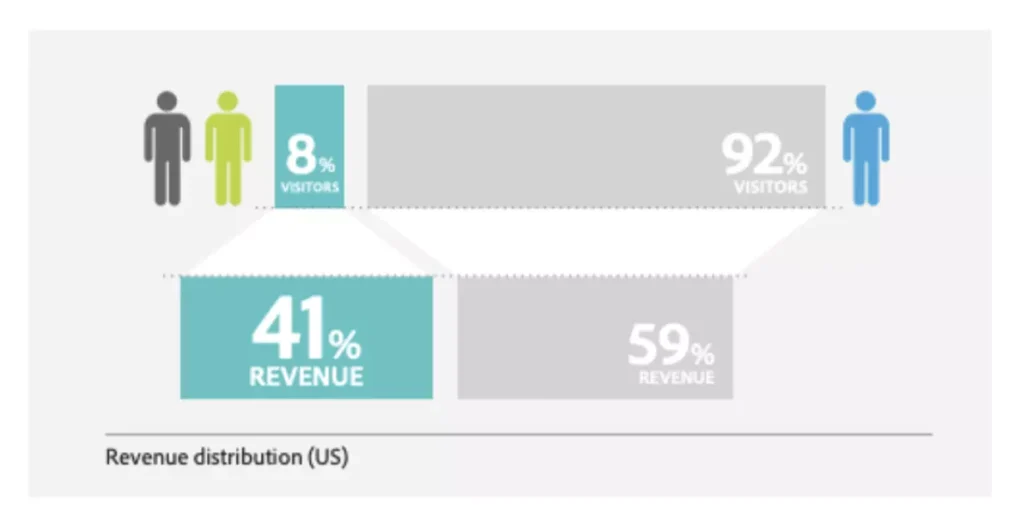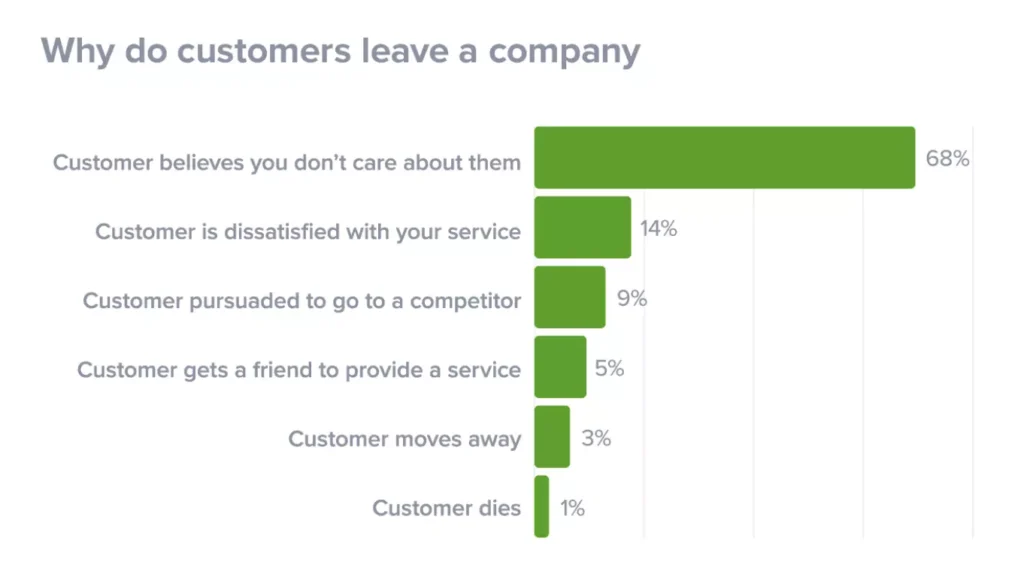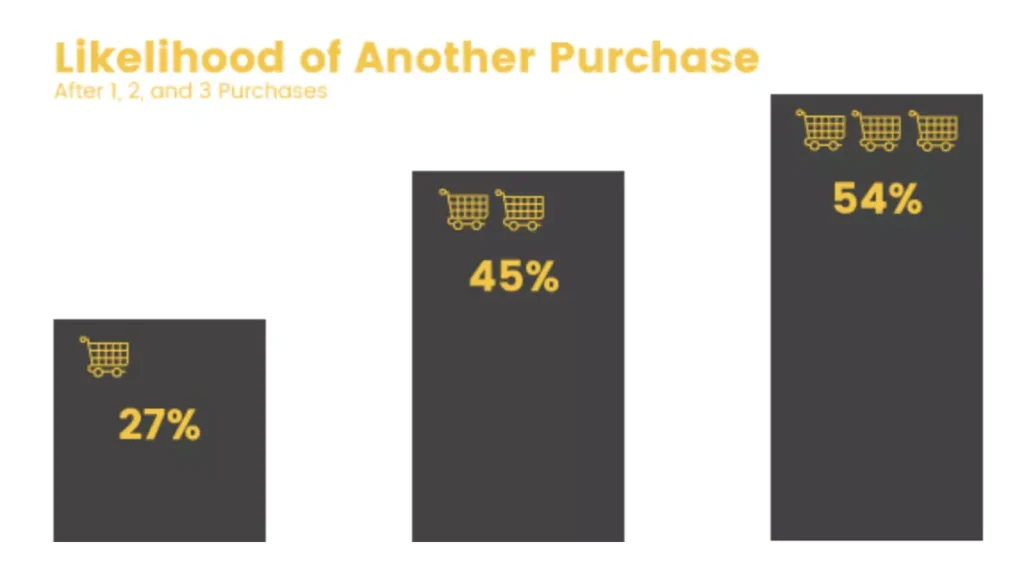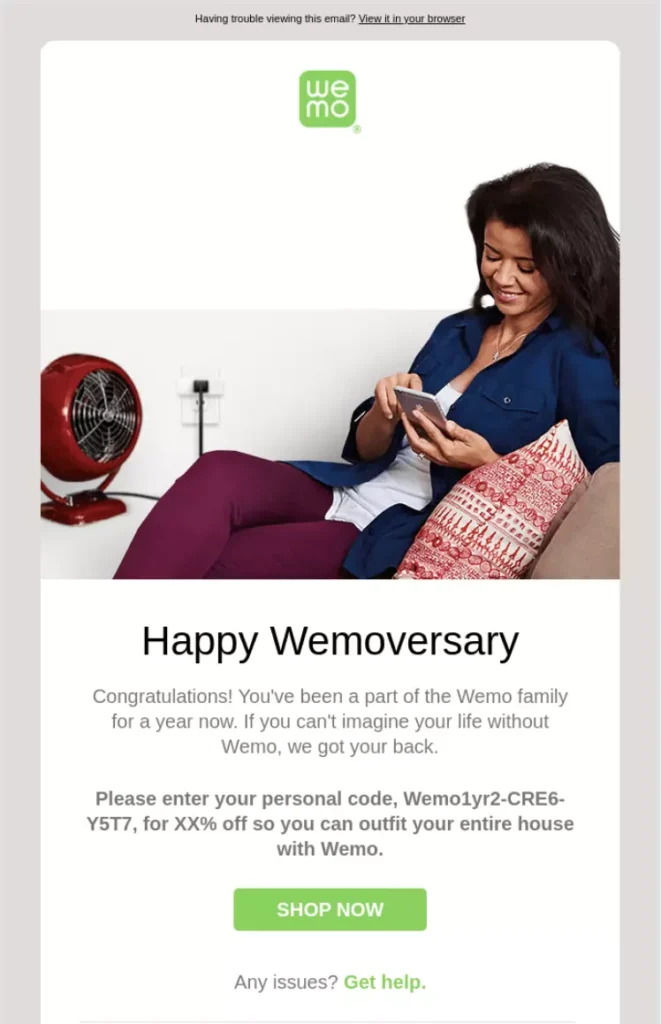Ecommerce customers are different today than even a couple years ago—forget decades ago. Increased competition and evolving consumer needs and wants makes it pretty much impossible to just dump a bunch of money into acquisition costs and sleep easy thinking your customers will stay loyal.
To scale today, ecommerce brands need to think about a complete customer experience instead of funneling money into pre-purchase/acquisition tactics. The typical ecommerce store devotes more than 80% of its budget to acquisition, and that habit needs to be broken. Merchants need to think about retaining customers through engaging and personalized post-purchase journeys instead of how much they can pour into ad spend and SEO.
Klaviyo is the platform to turn to to create engaging and personalized nurture sequences that care for customers beyond checkout, beyond the post-purchase journey of tracking and delivery, and all the way until they’re ready to make that critical second purchase.
In a nutshell, doing everything in your power to fight churn and retain a customer is worth it. And while you may think that sending a thank you email immediately after purchase is enough of a post-purchase experience to satisfy the needs of today’s consumers in the final stages of the customer journey, it’s simply not enough.
The post-purchase blip many online merchants need something more—something of a post–post-purchase experience that elongates customer and brand relationships well past their purchase’s delivery date.
The Basics: Stages of the Customer Journey
Since the creation of ecommerce, experts have sprouted up who dedicate loads of time to dissecting every thought, intention, like, dislike, and beyond that lies within the customer’s brain. After all, if an online merchant wants to sell more, the more they know about the inner workings of their target shopper is only going to help them crack the code to more sales and revenue.
As a quick primer for the rest of this post, let’s review the basic life cycle of how any Average Joe becomes your customer.
1. Awareness
This first stage happens as soon as a consumer realizes they have a problem to solve, a need to satisfy, and, well, something they need to shop for. For consumers, this is the first rumble in their tummy that they’re hungry to buy something that resolves their problems. For merchants, this is when it’s crucial for your brand to be on their radar.Before anyone can buy from your store, they need to at least know about your store. Spreading the word to shopping hopefuls about your brand is more work today than ever. In the land of ecommerce, competition is fierce and acquisition channels are plentiful. What was once a matter of composing a radio jingle or filming a commercial to air across stations local to your brick-and-mortar store, acquisition channels now also include:
- Social media
- Paid ads
- Organic search
- Blog posts
- Direct mail
- Podcasts
- Pretty much anywhere an eyeball can see.
The majority of merchants, more than 80%, count on their trusty email lists to get the word out about their store. Sixty-nine percent rely on social media engagement, followed closely by tactics like paid ads, social media ads, and SEO. Depending on your target audience and where they spend their time, it’s up to you, dear seller, to determine the best combo to get in front of people while considering both short-term tactics to grow and long-term strategies to sustain that growth.

2. Consideration
Now that people perusing the internet have seen your ad or clicked your blog post or scrolled by an influencer wearing your shirts on Instagram, your brand and goods are on their mind as they start making choices regarding their sudden needs. They start researching, they start comparing, they start parsing through the best and worst reviews of your stuff on the web—with so many choices today, consumers now use loads of resources to aid in making the right purchase for them.
In fact, 70% of buyers return to Google two or three times during this phase to continue their research, justifying more and more which brand they’ll choose each time. This is where it becomes critical to have ecommerce site must-haves up and ready to go. Craft quality descriptions on product pages, post high-def photos of goods, and place trust-inducing touch points around your website, e.g., positive reviews, guarantees, return policies, brand values, free shipping, first-prize ribbon won at the fair—you get the gist.
3. Acquisition
This is where shoppers are within inches of pulling the trigger and making a purchase. They’ve identified a burning desire. They’ve done their research homework. And now it comes down to sealing the deal at checkout. If you have the resources, this is the time when you’d start deploying retargeting ads, personalized recommendations in the inbox, or discount codes that are too tempting to pass up.
A smooth and seamless checkout process will make this part of the customer journey run like clockwork. However, if there’s friction, confusion, or surprise charges at checkout, your almost-customer won’t hesitate to head right to a competitor they researched during consideration.
4. Retention
This is where the post-purchase experience begins—as well as one of the hardest parts of the customer journey to master. Winning the first purchase is a shot of dopamine, but earning that coveted second purchase means you’re on your way to creating true customer loyalty. (Plus, retaining a customer is way cheaper than all the shenanigans you pulled to acquire them in the first place, but we’ll get into that in a few paragraphs.)
Your odds of retaining a customer and fighting off churn increase substantially the more the more you engage with them after they purchase. Even the initial messages you send to the customer, whether it’s a fun “thank you!” with the receipt or a note about shipping updates, are all immediately part of this retention phase.
However, too many ecommerce merchants send just one or two automated messages post-purchase before ghosting their new customers. This disengagement causes chances at repeat purchases to dwindle, and it leaves customers feeling unappreciated, unacknowledged, and like maybe your brand isn’t all they had hoped for after all.
In order to retain customers, ecommerce brands have to look for ways to continuously engage with first-time purchasers well beyond checkout. Don’t bombard or overwhelm, but consider sending emails with personalized cross-selling deals, loyalty discounts, or information and fun facts about your brand, the item they bought, or the mission your company is on.
You could even weave your brand into your tracking and protection strategies with Route. When you connect to Route, your company logo will show up every time someone uses the app to check their package’s whereabouts. And with seamless and fast issue resolution, those customers will feel like your brand’s care and trust has extended well past the purchase.
5. Advocacy
The final stage happens when your customer turns from brand loyalist to biggest fan. This means they’re spreading the word on social, raving about your store to friends and family, and overall touting your goodness to anyone who will listen. Having a healthy group of customers-turned-advocates adds immense value and clout to your brand.
Ninety-three percent of consumers say that customer reviews influence their decisions (ya know, the ones they’re making during Phase 2). Word-of-mouth advocacy drives around $6 trillion of annual consumer spending. And 90% of people are more likely to trust and buy from a brand recommended by a friend or family member.
All of that is to say that yeah, advocacy is a kind of a big deal.
The Costs of Stopping Cold at Post-Purchase
The majority of marketing dollars are pumped into the pre-purchase phases of the customer journey, but the reality is that first- or one-time customers are the least “valuable” in ecommerce. (We’re sure they’re lovely people, they’re just not best for your bottom line.) There could be several reasons for this.
Possibility #1It is a race to get your brand out into the world, plastered wherever you can get it. Being visible is a very important first step to making sure your customer well never runs dry, which leads many ecommerce marketers to endlessly prioritize the first three stages of the life cycle.

Possibility #2
The post-purchase experience is a hair more complicated. Customers that haven’t engaged for a while are less tempting than fresh blood faces, and it can be tricky to pin down what will entice them to return.
Are coupons too gimmicky? Are loyalty programs too hard to maintain? Maybe it’s a matter of just not having gotten around to building a nurture sequence. Whatever it is, this is the part of the journey that’s less formulaic than acquisition.
The truth is that even if you sell the greatest products of all time, that isn’t enough to retain a customer. If they feel abandoned, feel forgotten about, or persuaded to try out a slick competitor who engaged while you weren’t, you might as well say sayonara to revenue-boosting loyalty.
To help drive this point home even further, the data surrounding the value of a repeat purchaser versus a one-and-done customer is staggering.

- Repeat customers spend 67% more than new customers.
- The probability of converting an existing customer is 60–70% compared with a probability of only 5–20% for a new customer.
- If a customer returns to buy a third time, the probability of them coming back a fourth time increases to 54%.
- A 10% rise in customer retention yields a 30% increase in the value of the company.
- Another interesting stat is that only a 2% increase in customer retention has the same effect as decreasing costs by 10%. Decreasing costs increases profits proportionally.
Klaviyo Helps Ecommerce Brands Engage Longer, Retain More
This is a big call-to-action for ecommerce brands everywhere to extend customer engagement beyond their existing post-purchase experience. After checkout, after waiting five days for shipping, after delivery, after unboxing and enjoying their goods, customers suddenly find themselves in this gray space with your brand if you simply stop talking to them. And nobody, literally not a soul, enjoys being in ~The Gray Space~ in any relationship.
Klaviyo is the perfect solution for ecommerce stores looking to continue engaging (and enticing) customers for weeks, months, or years (!) past their first purchase with your store. Or, in other words, it’s an ecommerce marketing platform capable of helping you build and perfect a post-post-purchase experience.
Depending on what you sell, from toothpaste to mattresses, the time it takes a customer to make a second purchase could be just days or it could be years. Whatever the average time to repeat purchase is for your store, sending relevant, engaging, and continuous email sequences between purchases is the key to retaining customers longer.
Emails sent during this part of the customer journey could be what creates retention and advocacy, as well as:

- Tempt people to come back to your site
- Lay the groundwork for a second purchase
- Attain feedback from customers
- Create a great customer experience
Plus, according to Klaviyo’s deep vault of data, these types of emails see a 217% higher open rate, over 500% higher click rate, and 90% higher revenue per recipient than your average email campaign.
Klaviyo’s innate benefit of offering smart segmentation ensures you only send emails that are most relevant to each individual customer and their interactions with your store.
No more overbearing, faceless glob of an email recipient list to send generic messages to—otherwise known as one that customers will see as irrelevant and impersonal as they hit “unsubscribe.”REMEMBER
The #1 reason customers stop coming back is that they don’t believe your brand gives a darn about them.
Once you have your post-purchase experience nailed down, start considering the months beyond package delivery. Are you engaging with your customers and reminding them that your store exists? Are you stoking fond memories of the items you sold to the customer? Are you showing appreciation for that purchase they made one time?
Crafting an automated email sequence to fill the space between purchases is one of the best ways to increase retention and reduce churn. And with a platform like Klaviyo, it’s easy to automate, personalize, and optimize the best post-post-purchase experience this side of the Mississippi.
Rethink Your Post–Post-purchase Experience Pronto
Whether you’re just starting or your online store is well-established, it’s time to take the spotlight off the first phases of your customers’ journey. Turning the dial toward post-purchase strategies and loyalty-inducing customer experiences will sustain your store for years to come.
Short-term strategies like real-time visual tracking, frictionless claims filing, and protection against damaged or stolen packages with Route ensure your customers are at their happiest from checkout to delivery while building trust and good relationships. But long-term strategies that happen in the weeks and months post-purchase are what drive long-term retention between first and second purchase.
In tandem, Route and Klaviyo provide an unbeatable experience for your customers. The engagement, personalization, and authentic care ecommerce stores can show toward customers with these platforms is what will have your store standing shoulders above the competition.